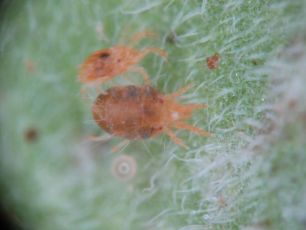
Tomato red spider mite
| Primefact number | Edition | Published | Author |
|---|---|---|---|
| 1319 | Second | Jul 2018 | Plant Biosecurity and Product Integrity |


Tomato red spider mite, (Tetranychus evansi) is an established plant pest in NSW. It is a small, red coloured arachnid that feeds on the sap of plants.
The vegetable crops of tomato, eggplant and potato are among the hosts of tomato red spider mite. Weeds in the Solanaceae family are also hosts of tomato red spider mite.
Management actions to prevent spread are recommended.
Notifiable status
Tomato red spider mite (Tetranychus evansi) is not a notifiable plant pest in NSW. A full list of notifiable plant pests and diseases can be found in Schedule 2 of the NSW Biosecurity Act 2015.
Damage
The tomato red spider mite can be found on both sides of leaves but it prefers the undersides near the leaf veins. Feeding causes leaves to become yellowish white and mottled.
Tomato red spider mite produces webbing, especially on the undersides of leaves. In high infestations, dense webbing can mummify plants. Leaf defoliation follows infestation and plants may die in severe attacks (Figure 2).
Description
Adult tomato red spider mites are small in size with eight legs. Mites are difficult to see without magnification. Tomato red spider mite may change colour during it's lifecycle. They can vary in colour from light orange to deep orange red or brown (Figure 1).
Female tomato red spider mites are approximately 0.5 mm in size and a broad oval shape. Males are much smaller (0.3 mm), orange to straw coloured and are a more elongated, triangular shape.
Eggs of tomato red spider mites are rounded and deep to pale orange in colour. They are bright and clear when newly laid becoming rust red prior to hatching.
Larvae are light green or pinkish in colour, slightly larger than eggs and have six legs.
Nymphs look similar to adults with eight legs but are smaller and greenish to orange red in colour.
The tomato red spider mite resembles some other common spider mites such as the two spotted mite (Tetranychus urticae) and bean spider mite (T. ludeni).
Lifecycle
Tomato red spider mite continuously reproduces throughout the year in warmer climates.
Development is favoured by hot dry conditions.
The minimum temperature for growth is 10 °C and the optimum temperature is 34 °C.
At 25 °C, the lifecycle is completed in 13.5 days and the number of eggs laid can vary from approximately 80 eggs at low temperatures to 120–250 eggs at higher temperatures.
Host range
The main hosts of the tomato red spider mite are plants in the Solanaceae family including weeds such as blackberry nightshade (Solanum nigrum) and glossy night shade (S. americanum), and the native kangaroo apple (S. aviculare).
Commodities affected by tomato red spider mite include tomato, potato, eggplant, beans, citrus, cotton, tobacco and ornamentals such as roses.
Tomato red spider mite can cause damage to plants grown both outdoors and in glasshouses.
Distribution
Tomato red spider mite is thought to originate in South America and has been introduced to many countries in Africa, Europe, Asia and North America including Hawaii.
Overseas information shows that the tomato red spider mite can displace other common spider mites in new areas of infestation.
Spread
Local movement is linked to wind currents. Short distance spread can occur through contaminated clothing and tools. Mites can walk short distances. Long distance spread occurs through the trade of infested host plants.
Management actions
- there are currently no registered miticides for use against T. evansi in Australia
- chemical resistance is a major problem overseas, requiring rotation of miticides
- manage weeds especially blackberry nightshade and glossy nightshade
- treat, remove or quarantine infested plants to prevent spread
Actions to minimise risks
Put in place biosecurity best practice actions to prevent entry, establishment and spread of pests and diseases:
- good farm hygiene practice - "Come Clean, Go Clean"
- ensure all staff and visitors are instructed in and adhere to your business management hygiene requirements
- source propagation material of a known high health status from reputable suppliers
- monitor your crop regularly
- keep records
Acknowledgements
Figure 1 courtesy of Alain MIGEON and Franck DORKELD (2006-2013) Spider Mites Web: a comprehensive database for the Tetranychidae. http://www.montpellier.inra.fr/CBGP/spmweb
Figure 2. courtesy of Alain MIGEON http://www.dnw.boku.ac.at/fileadmin/_/H95/H953/Angewandte_Entomologie/WS11_12/Sch%C3%B6nhuber.pdf

